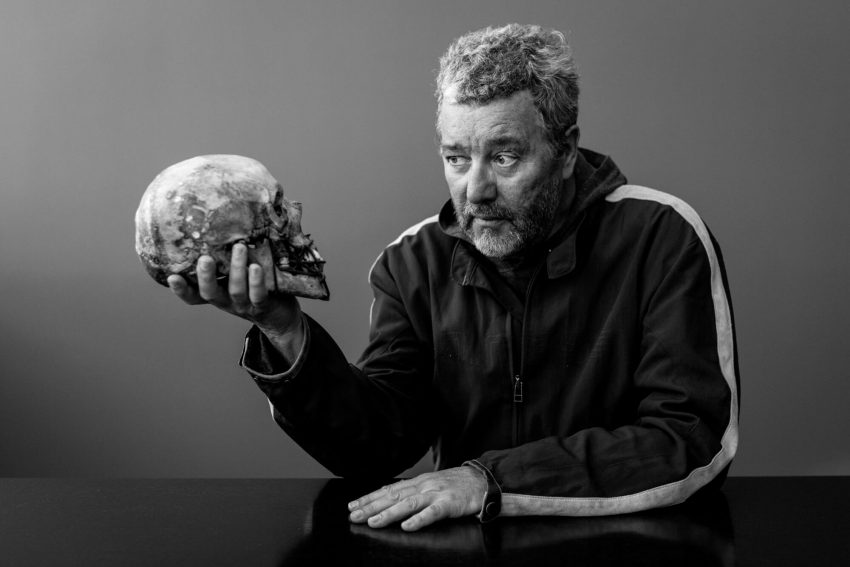There is no designer more versatile, romantic, eccentric and genius in his craft than Philippe Starck. The great designer deals with literally everything, from the essentials of everyday life to grand designs for buildings, aeroplanes and yachts. There is probably no young designer who has not heard of Philippe Starck or is not familiar with his work. Perhaps that is why his masterpieces are often copied and counterfeited.
Biography of Philippe Stark
Philippe Starck was born in 1949 into such a family that the talent he possesses comes as no surprise. Two poles combined in Philippe, two different people. His father worked as an aircraft designer, so an atmosphere of perpetual design, drawings and layouts constantly surrounded Philippe. On the other hand, his mother, an artist, instilled in her son a love of beauty, understanding and a subtle sense of beauty and harmony. A passion for modelling, for remaking old things, for assembling and disassembling different techniques, for giving a second life to forgotten objects, took Stark to the great heights of the art of design.
Philippe Starck studied at the prestigious Camondo School. It is a public school of design and interior design. The graduate did not take the easy path of an ordinary designer or planner in any company. He went a step further. Already in 1968, he founded his own design company. Gradually, the company grew thanks to the original projects Stark carried out. And these were nightclubs. His ideas were so sweeping that he quickly became recognised as a kind of provocateur in the design world. He himself used to say: “I’m a revolutionary; I don’t fit into boxes, I create them”. It was, and still is, true.
The turning point in Philippe Starck’s career was the invitation from French President Mitterrand to redesign the Elysée Palace. The ambitious designer, who had already amazed connoisseurs and amateurs with his design masterpieces, literally woke up famous. Orders poured in from the horn of plenty. Everyone and everywhere wanted to work with the well-known master.
The diversity of his interests is simply amazing. His hand and his imagination design: hotels, hotel clubs, restaurants, coffee machines, furniture, smart phones, bathrooms, eyeglasses, lighting fixtures, museums, yachts and much more.
In 1969, Stark worked closely with Pierre Cardin. Soon after, however, he decided to focus primarily on industrial design, which resulted in masterpieces in all these fields.
In addition, as a partner of Philippe Starck, the company Baleri Italia, which is the largest manufacturer of designer articles and accessories for the home, can be named after him.
The popularity of the designer and the love for his works is so great that a large part of the exhibitions of the Museum of Decorative Arts in Paris and the Design Museum in London is represented by his work.
The fundamental principle of all Philippe Starck’s activities is a great love and respect for people. Hence the desire to make everything, even the smallest thing, beautiful, elegant, comfortable and original.
Projects in the field of architecture and interior design
Maison Baccarat Hotel in Moscow. It was built in 2008 and looks like the mirror world Alice was transported to in a fairy tale about Wonderland. There is glass, crystal, shiny surfaces, gold and silver everywhere. Everything is so fragile and elegant that at first glance it is hard to believe that this is an area where real people live.
The restaurant Le Paradis du fruit Roots in Paris is a delicious and aromatic mix of fruits. They are everywhere: on the walls, in the furniture, in the lighting and, of course, on the menu. Fruit takes us back to warm countries, to a happy childhood when we could enjoy life. Portraits with children’s faces that give off grimaces, as if inviting us to sit down at the table and get into a bit of mischief.
The Asahi headquarters (Tokyo) is a striking example of modern expressionism. Philippe Starck is considered the master of this particular artistic movement, having designed the exterior of the Asahi brewery. Take a closer look at this architectural masterpiece. Lots of power, expression, dynamism and lightness at the same time.
Philippe Starck’s numerous architectural projects include more:
- The State College of Decorative Arts;
- Volare nightclub (Shanghai);
- Waste treatment plant (Paris);
- Hotel Palazzina Grassi (Venice);
- Hotel Le Meurice (Paris);
- Alhóndiga Bilbao Cultural Centre (Spain);
- Restaurant and bar of the Mama Shelter Hotel (France);
- Hotel Fasano (Rio de Janeiro) and others.
Philippe Starck’s furniture and lighting projects
Philippe Starck is no stranger to extravagance when it comes to designing furniture and lighting. There are several models that are widely copied and even imitated.
Plastic armchairs. Only Philippe Starck could think of combining two completely different concepts and eras in a single piece. The Victorian era and Louis XV style furniture are embodied in the light, transparent plastic, the material used to make street café furniture. But it all comes together so organically that there is no sense of disharmony.
Philippe Starck’s luminaires are refined on the one hand and provocative on the other. The combination of classic and modern is always a surprising result. No luminaire seems pretentious or provocative.
The Zenith Noir chandelier was designed by Starck for the Baccarat headquarters in Paris. The magnificent black glass piece is strikingly elegant. The chandelier is made in the classical tradition. But Philippe Starck did not hold back and created an ironic copy of the chandelier in white, but attached an ordinary umbrella to it.
Table lamps deserve special attention: a machine gun or a pistol instead of a chandelier, an Al Capone hat instead of a lampshade, a space meteorite as a top? Yes, that’s right. These are all Philip Stark’s table lamps. Unconventional ideas at the same time as the use of expensive materials, such as gold plating, together with cheap plastic – all this is eclecticism from the famous master.
You may also like:

